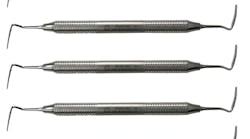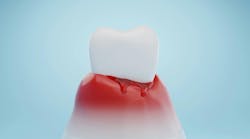When to refer to a periodontist: Common clinical findings and risk factors
As hygienists know, very little in dentistry is black and white. This can be frustrating when you’re trying to make clinical decisions and provide the best care, or when determining whether to refer a patient to a periodontist for surgical treatment and periodontal disease management.
To provide some help with this dilemma, I’ve put together a list of common clinical findings and risk factors to help hygienists through periodontist referral decision making. Although each patient is unique and there are some discrepancies in the comfort levels of practitioners handling periodontitis patients, hopefully this list will provide some guidance.
Gingival recession
Gingival recession is a common finding in dental offices, with the prevalence ranging from 40% to 100%, depending on the patient population and method of analysis.1 However, this does not mean that every patient with recession requires a referral to a periodontist and gingival grafting.
If a patient is complaining of dentinal hypersensitivity from recession without relief from other methods, or is unhappy with esthetics, a referral might be worth discussing. Otherwise, the clinician must consider if the patient has adequate keratinized tissue in the areas of recession, furcation involvement, and their phenotype, the thickness of their gingival tissue.1
Unresponsive to nonsurgical periodontal therapy
If your patient still has deep probing depths, bleeding, and inflammation after nonsurgical periodontal therapy (scaling and root planning [SRP]), referral to a periodontist may be indicated. Research shows that clinicians often fail to completely remove calculus deposits when pockets exceed 5 mm.2
Therefore, if there are residual periodontal pockets deeper than 5 mm following SRP, it may be time to consider referral for a gingival flap or further periodontal treatment. Sometimes even with adequate calculus removal, a patient may continue to have deep probing depths due to bony defects.3 In this case, the patient would likely need osseous surgery.
Refractory periodontitis
Although most patients respond well to SRP and regular maintenance visits when there’s satisfactory self-care, there is a small group of patients who do not.4 This can be baffling and frustrating for both patients and clinicians. If a patient continues to experience attachment loss despite good home care and keeping up with perio maintenance visits, they likely need a periodontist referral. The periodontist may investigate further into systemic factors that could be causing disease progression, identify specific bacteria causing the issue, and prescribe antibiotics as needed.5
Advanced periodontitis
The hygiene and general dentist team is more than capable of treating patients with gingivitis and most patients with periodontitis. However, depending on the extent and complexity of the case, patients with stage III or stage IV (advanced) periodontitis and grade C (rapidly progressing) periodontitis often need referral to a periodontist to effectively manage the disease and prevent further tooth loss and periodontal destruction.
But this doesn’t mean these patients leave your practice forever. They can usually be comanaged between the general dentist and periodontist for alternating recalls and restorative care.6
Implants and peri-implantitis
Although many general dentists place implants, there may be situations when a dentist wants to refer to a periodontist for implant placement due to the complexity of the case. One example is if the patient needs additional surgery prior to implant placement, such as bone grafting or a sinus lift. Additionally, the expertise of a periodontist may be valuable for the placement of anterior implants due to a patient’s esthetic concerns and the possibility of needing grafting in this area.
If signs of peri-implantitis become evident with increasing probing depths and bone loss, surgical therapy in combination with an osseous resective or regenerative approach by a periodontist may be necessary to reduce the pocket depth and increase the longevity of the implant.7
Crown lengthening
Lastly, you could refer to a periodontist for crown lengthening. The reasons for crown lengthening are either esthetic or functional. An esthetic reason is a gummy smile with excess gingival display and the appearance of short clinical crowns. Functional reasons are exposure of subgingival caries or a fracture. Crown lengthening may also need to be performed prior to a crown restoration placement if the crown margin needs to be placed close to the osseous crest impinging the biologic width, which could otherwise result in chronic inflammation.8
Although this is by no means a full list of reasons a patient may need to be referred to a periodontist, this is a guide of clinical conditions to be aware of when considering referral. No patient or dental office is one-size-fits-all, so sometimes generalizations are not possible.
Hygienists spend a significant amount of time examining the periodontium and assessing for signs of periodontal disease. We’re often the first person in the dental office to recognize periodontal issues that may warrant referral to a periodontist, and possible comanagement between the dentist and periodontist.
References
1. Imber JC, Kasaj A. Treatment of gingival recession: when and how? Int Dent J. 2021;71(3):178-187. doi:10.1111/idj.12617
2. Caffesse RG, Sweeney PL, Smith BA. Scaling and root planing with and without periodontal flap surgery. J Clin Periodontol. 1986;13(3):205-210. doi:10.1111/j.1600-051x.1986.tb01461.x
3. Cobb CM. Non-surgical pocket therapy: mechanical. Ann Periodontol. 1996;1(1):443-490. doi:10.1902/annals.1996.1.1.443
4. Magnusson I, Walker CB. Refractory periodontitis or recurrence of disease. J Clin Periodontol.1996;23:289-292. doi.10.1111/j.1600-051X.1996.tb02091.x
5. Kornman KS. Refractory periodontitis: critical questions in clinical management. J Clin Periodontol. 1996;23:293-298. https://doi.org/10.1111/j.1600-051X.1996.tb02092.x
6. Gehrig JS, Shin DE. Foundations of Periodontics for the Dental Hygienist. 6th ed. Jones & Bartlett Learning; 2024.
7. Mahato N, Wu X, Wang L. Management of peri-implantitis: a systematic review, 2010-2015. Springerplus. 2016;5(2):105. doi:10.1186/s40064-016-1735-2
8. Hempton TJ, Dominici JT. Contemporary crown-lengthening therapy: a review. J Am Dent Assoc. 2010;141(6):647-655. doi:10.14219/jada.archive.2010.0252
About the Author

Amy Lemons, MEd, BSDH, RDH
Amy Lemons, MEd, BSDH, RDH, has 13 years of experience and is currently a clinical assistant professor at the OU College of Dentistry in the division of periodontics. She teaches preventive dentistry and periodontal instrumentation to first-year dental students. Most of her work focuses on sharing clinical tips and the latest information in periodontics. Reach her at [email protected].


